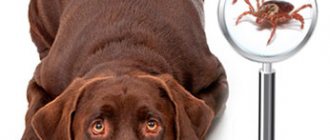An arthropod bite in itself cannot seriously harm a pet’s health. If a tick attaches itself to a dog, inflammation, itching, or a small abscess may occur at the site of the bite. But infectious diseases carried by parasites can cause health problems and cause the death of a dog. Therefore, you should carefully examine your pet after each walk and, if you find a tick, seek help from specialists.
The dog was bitten by a tick, what to do next: first aid
Beginners, when faced with the problem for the first time, are lost and do not know what to do if the dog is bitten by ticks. First you need to calm down and examine your pet. It is possible that there are other arachnid parasites on the animal’s body. Ticks typically choose soft and easily accessible areas such as the neck, abdomen, inner thighs, armpits, ears and head. Then you need to remove the parasite and provide first aid to your pet.
Also read an important article on the topic: “Protecting your pet from ticks: a review of the best remedies.”
How to remove a tick yourself
Do not pull the tick by the abdomen, use thread or tweezers with sharp edges, or treat the bite site with oil or kerosene. The abdomen may tear, making it more difficult to remove the parasite. Treatment with oils and kerosene will lead to the death of the tick, but during the time it remains in the animal’s body, the parasite can inject an infection into the wound. These methods can harm not only the tick, but also the pet.
Before removing a tick, you need to put on gloves, prepare a tool, and a jar for the parasite. Special twisting tools or tweezers with round edges are best. If you don't have the right tool at hand, you can pull the tick out with your fingers.
Stages:
- You need to move the fur apart or trim it a little in the area of the bite.
- Treat the puncture site with alcohol or other antiseptic.
- It is necessary to grab the tick as close to the head as possible.
- You cannot tug or pull the parasite. It is necessary to unscrew the tick from the wound.
- The parasite is placed in an airtight jar.
Pets usually react poorly to the procedure. But if the dog shows anxiety, it needs to be calmed or restrained.
We removed a tick from a dog, what to do next?
The wound after a tick is treated with alcohol-containing or antiseptic agents. The tick can be crushed, burned, or thrown away in an airtight jar.
But if tests are planned, the tick must be preserved. Using a laboratory test, you can find out whether the tick was a carrier of a dangerous disease.
When to go to the vet
Your pet should be shown to a doctor if:
- Unfavorable epizootological situation in the place of residence.
- The dog is covered in ticks. Even in the absence of hidden diseases, numerous bites can be harmful to health.
- The dog exhibited alarming symptoms that could be the cause of a dangerous disease. Such as vomiting, diarrhea, weakness, depression, shortness of breath, etc.
It is not recommended to take medications before visiting the veterinarian. They can blur symptoms and make diagnosis difficult.
What is piroplasmosis
The disease is caused by an intracellular parasite, Babesia, which is very small in size and parasitizes the red blood cells of the victim. The carrier of the disease is the ixodid tick (intermediate host), after the bite of which the microorganism enters the dog’s body and begins to destroy the animal’s red blood cells.
Babesia can be found in the stomach, genitals and salivary gland of the tick and can even be transmitted to the insect's offspring. When a dog bites a dog, the tick digs deep into the dog's skin, sucks out the animal's blood, and then injects it back into the wound. As soon as the microscopic parasite enters the bloodstream, it invades red blood cells (erythrocytes), begins to feed on the contents of the cell and actively reproduces.
After the blood cell is completely destroyed, the microorganism leaves its refuge and goes in search of new red blood cells. Macrophages (immune cells) capture and remove destroyed red blood cells from the body, but since piroplasmosis quickly destroys a significant number of blood cells, macrophages cannot cope with their task. An animal infected with piroplasmosis begins to suffer from severe intoxication.
If you didn’t immediately notice that your dog has a tick
It happens that a tick bite goes unnoticed by the owner. You can find a crushed parasite on the floor that has drunk blood and fallen off on its own. Sometimes the parasite is detected on days 5–7 . At this time, the tick looks like an inflated balloon.
It is not difficult to remove such an insect. It is enough to grab it with your clubs closer to the head and pull. Most likely, he can easily detach himself from the dog. If the pet feels well and does not show anxiety, then there is no reason to panic. It is necessary to observe behavior and condition.
Unfortunately, some diseases transmitted by arthropod arachnid parasites are hidden and have a long incubation period.
To avoid complications, you need to take your dog to see a veterinarian and submit the tick to a laboratory for analysis.
Warning symptoms and signs
If a tick has bitten into your dog, you should pay attention to the symptoms that are typical of infectious diseases.
Groups of symptoms:
- General : decreased or lack of appetite, anxiety, lethargy, itching, diarrhea, vomiting, decreased activity.
- Local : pain in the area of the parasite bite, hyperemia of the mucous membranes and skin, swelling, purulent discharge from the nose and eyes.
- Neurotoxic : impaired coordination and swallowing reflex, shortness of breath, limb failure, pulmonary edema.
General symptoms depend on the dog’s immunity, the disease, the type of tick, the general condition of the pet’s body and associated complications. You should immediately seek help if your dog develops one or more symptoms. Since some diseases occur rapidly and can lead to the death of a pet.
Dangerous symptoms:
- convulsions, paralysis;
- temperature increase;
- diarrhea, vomiting (bile);
- pallor or yellowness of mucous membranes;
- heart failure;
- slower reactions;
- mood swings from passivity to aggression;
- coffee-colored urine.
It is important to remember that in puppies, old, weakened and decorative (small) animals, the disease progresses rapidly, and the changes are often irreversible. Therefore, it is necessary to contact the clinic immediately after detecting the parasite.
You should be aware that if your dog has any symptoms and the parasite is not detected, the disease may be caused by a subcutaneous tick. Like ixodid arachnids, this type of parasite is capable of transmitting dangerous infectious diseases. And also, one should not exclude the possibility that the tick has already fallen off and safely disappeared into the nearest park.
Symptoms of the disease
The tick itself is not particularly dangerous; it drinks only a few milliliters of blood, after which it leaves its intermediate host. However, in case of serious damage, when there are dozens of such bloodsuckers on the animal’s body at the same time, the dog may experience discomfort, irritation and itching. The pet will often itch and behave restlessly. The greatest danger from tick bites is the infections that this parasite carries.
It is not always possible to notice these blood-sucking insects with the naked eye in a pet’s thick fur, so it is necessary to pay attention to the dog’s condition and take into account the signs that indicate that the animal is infected with a parasite. It should be said that all breeds, without exception, are at risk of being bitten and infected by ticks.
It is customary to distinguish the following reactions and symptoms of a dog to a tick bite:
- neurotoxic;
- local.
In neurotoxic reactions, tick paralysis is noted, and a gradual deterioration in the animal’s condition occurs.
The dog's limbs may be taken away, the back part of the body ceases to function, the vessels supplying the brain fail, suffocation and death occur. Yorkies and small Spitz dogs may have seizures and jaundice. Such neurotoxic reactions occur when the pet owner does not promptly contact a veterinarian and does not take any action to treat the animal.
The first local reactions can appear within a few hours after the parasite bite. In short-haired dog breeds, changes on the skin can be seen with the naked eye, and a tick swollen from drinking blood also becomes visible. Such local symptoms usually include redness of the skin area around the bite, irritated behavior, itching and scabies.
What diseases can a tick bite transmit?
By and large, a tick bite is no worse than a mosquito bite. If the parasite is not infected with a dangerous disease, then the dog’s health is not in danger. But if the tick is a carrier, it is necessary to take measures for diagnosis and treatment. It should be remembered that many diseases are dangerous not only for animals, but also for humans.
Symptoms and common diseases:
- Encephalitis : incubation period 10–14 days, rapid progression. Characterized by damage to the cerebral cortex. Symptoms: the dog is lethargic after a tick bite, lack of coordination, tremors, refusal to feed, convulsions, paralysis of the limbs, loss of hearing and vision, fever. In the absence of vaccinations and timely treatment, it ends in the death of the pet.
- Borreliosis : chronic course with timely treatment, complete recovery. Signs: joint pain, swollen lymph nodes, decreased activity, lameness, arthritis, inflammation of muscle tissue and blood vessels.
- Piroplasmosis (babesiosis) : incubation period from 1 to 20 days, chronic course. Symptoms: refusal to feed, weight loss, pain on palpation of muscles and internal organs, thirst, depression, vomiting, diarrhea, pallor or yellowness of the mucous membranes and skin, shortness of breath, coffee-colored urine, spasms and convulsions. If left untreated, the animal dies.
- Bartonellosis : incubation period from 3 months to 2–3 years. With help, the dog makes a full recovery. If bartonellosis is not diagnosed and treated, the dog dies from pulmonary edema. Symptoms: loss of appetite, rapid weight loss, depression and apathy, disruption of the heart and lungs, hemorrhage, weakness and failure of the hind limbs, inflammation of the eyelids.
- Ehrlichiosis : occurs secretly or with pronounced typical symptoms. A disease of a hematological nature, characterized by a disruption of the hematopoiesis process. Symptoms: thirst, depression, pain on palpation, convulsions, fever, inflammation of muscles and internal organs, blood in the urine, anemia of the skin and mucous membranes, hemorrhages on the mucous membranes of the nose and eyes.
- Hepatozoonosis : the incubation period can last from several months to several years and directly depends on the general condition of the animal’s body. Sometimes dogs become asymptomatic carriers. Symptoms: body temperature, muscle and joint pain, purulent discharge from the eyes and nose, general weakness and decreased activity.
To correctly identify the disease, it is necessary to undergo a full examination, since many signs are characteristic of different diseases. It should also be remembered that piroplasmosis may not be detected during the initial examination. For a more accurate result, it is necessary to repeat the analysis.
How to do a smear for piroplasmosis?
Capillary blood is collected from the animal’s ear as follows:
- shave the hair from the inside of the ear
- treat the skin with a disinfectant
- make a small skin incision
- a drop of blood is placed on a glass slide
- form a smear
- the preparation is dried and stained with Diff-Quick
- cover with a cover glass
- study the sample using a microscope.
The results of the analysis for piroplasmosis can be obtained at the first appointment
Treatment of a pet at home
You should not self-medicate at home until a diagnosis is made. All medications and procedures must be prescribed by the attending physician after examination and tests.
Very often, the period of treatment and rehabilitation takes several months. The time depends on the type and nature of the disease, the selected therapy and the sequence of treatment. If you decide to treat your pet at home, you must follow the doctor’s recommendations and complete the full course. This is very important, since many diseases can “fall asleep” for a while, and then manifest themselves with a vengeance.
List of drugs
Typically, therapy is aimed at suppressing the disease, secondary symptoms and complications. And also to stimulate the body, strengthen the immune system and remove toxins.
Therefore, most often the complex of drugs is different and suitable for the treatment of a specific disease.
| General list of drugs aimed at treating and suppressing symptoms | |||
| Drugs | Action | Method of administration | Purpose |
| Antibiotics: Dioxycycline, Clindomycin, Azithromycin. | Suppression of pathogenic microflora, relief of inflammation | intramuscularly | Veterinarian |
| Antiprotozoal: Fatribanil, Azidine, Berenil, Imizol, Imidocarb | Antibabesia drugs | intramuscularly | Veterinarian |
| Vitamins of group B, C, A. | Strengthening the immune system, stimulating the body. | Intramuscularly, subcutaneously, orally. | Veterinarian, independent use. |
| Immunostimulating: Hepatal, Hepatovet, Gamavit. | Strengthening the immune system, stimulating the body. | Intramuscularly, subcutaneously, orally. | Veterinarian, independent use. |
| Nosh-pa | Relieving spasms and pain. | Subcutaneously, intramuscularly, orally. | Veterinarian, independent use. |
During treatment and the rehabilitation period, it is necessary to follow a diet and limit physical activity. To monitor their health, conditionally healthy pets should visit the veterinarian at least 2 times a year.
Treatment of piroplasmosis
After making an accurate diagnosis, the veterinarian prescribes an individual treatment regimen. First of all, it is necessary to rid the dog’s body of microscopic parasites. For this purpose, highly toxic drugs are used:
- Imidosan;
- Pyrostop;
- Azidine;
- Berenil.
After the administration of drugs, the pet may experience a deterioration in its condition due to poisoning of the body with dead parasites and destroyed blood cells.
At this time, it is very important to support the function of many organs that are working hard (liver, heart, kidneys, immune system).
Maintenance therapy is required using:
- hepatoprotectors;
- saline solutions;
- vitamin complexes;
- cardiac drugs;
- glucose solution.
In especially severe cases, plasmapheresis and blood transfusion are used. Due to the high cost, the blood purification procedure is not carried out in all veterinary clinics.
The sick animal is prescribed a special diet that reduces the consumption of fats and protein, as well as raw vegetables and fruits. It is necessary to introduce fermented milk products into your dog’s diet. Biochemical examination of blood and urine is carried out every 2 weeks in order to monitor the dynamics of the animal’s condition.
Veterinarian answers to key questions
Very often, when faced with a bite problem, owners are not aware of the consequences. To understand the situation, you need to study all available information or seek advice from specialists.
Can a dog die from a tick bite?
A dog will not die from a simple bite . You should also know that not all ticks are carriers of diseases. In addition, infection takes time, and a parasite detected and removed in time will not have time to infect the dog.
But if time is lost, and the tick has managed to suck, you should show the dog to a doctor. If all this is left unchanged, then the cause of death can be dangerous diseases.
The dog still has a tick head, what to do?
If such a situation arises, you can seek help from a clinic or wait for natural rejection of the parasite. If the dog is healthy, the body itself will expel the foreign body. Most likely, swelling and inflammation will develop at the site of the bite. If the process is not complicated by other symptoms, the head will come out through the wound along with pus and ichor. In case of complications, you must contact the clinic.
How to understand that a tick was infectious
Infected and uninfected ticks have no external differences. It is possible to find out whether the parasite is a carrier only through laboratory tests. To do this, you must submit a live tick for analysis no later than 2 days.
If for some reason the tick remains in the dog, you can bring your pet to an appointment with a veterinarian. Specialists will remove the tick and send it for analysis.
How dangerous is it if a tick bites a pregnant dog?
After a bite, you should not wait for symptoms to appear. You must contact the clinic immediately. This will help maintain the health of the mother and future offspring. It is important to remember that diseases will primarily affect the health of embryos and can lead to the death of unborn children and the mother.
Do dogs get tick vaccinations?
Vaccinations do not protect your dog from ticks. The action of the drugs is aimed at protecting the body from diseases carried by parasites. For the purpose of protection and prevention, you can vaccinate your pet against tick-borne encephalitis and piroplasmosis (Eurikan Piro, Piro Stop).
Types and description of ticks
Ticks attach to a dog very quickly, because the skin under the animal's hair is very delicate and easily susceptible to insect attack. But don't rush to remove the parasite. Each species is unique and the fight against it has its own nuances.
In total, scientists have counted about 40,000 dangerous species of ticks. Only a few take root in the Russian climate.
Let's look at the most common varieties.
Ixodid ticks
Adult insects have hard chitinous plates that protect the body from external factors. The tick looks scary, because its size is on average 2.5 cm, and when it parasitizes an animal, it increases several times.
This tick lives in central Russia. Most often it hides in leaves and bushes. It can also be dangerous for humans. Capable of laying up to 17,000 eggs, from which larvae emerge. They multiply quickly. The adult is brown in color, the young is yellow.
Argaceae
Can be found in outbuildings, old houses, bird nests. They most often parasitize domestic animals and cattle. Rarely, but can affect humans. The bite of this insect is painful; itching and burning immediately occur.
The parasite has a light color, its body is practically unprotected by anything, so the animal can brush off the tick, but its trunk will remain, which can cause skin diseases.
Armored mite
Its habitat is the top layer of soil. Less commonly found on trees. It feeds on mushrooms, plants, and lichens. Dangerous for poultry and animals. Carries helminths.
Subcutaneous (sarcoptoid)
It parasitizes both humans and animals. Feeds on dead skin. It causes itching and burning.
The subcutaneous mite is very difficult to recognize. It has a white tint and is small in size, so it camouflages well. Lifespan up to 3 months. During this time, he manages to lay more than 100 eggs. Internal ticks are especially dangerous in dogs.
Scabies
It becomes the cause of an unpleasant disease - scabies. Parasitizes humans and animals. It feeds on secretions released from the skin. It is easily distinguished, as it has a gray tint and impressive size. In areas after a tick bite, the dog experiences redness and itching. Lives up to one and a half months.
Read Causes and symptoms of strange breathing in dogs
What signs can you use to determine if your pet has ticks?
Once filled with blood, it is not difficult to find a tick on the body. The parasite grows to the size of a large bean, changing its usual color to reddish.
The manifested symptoms are divided into 3 large groups:
- Local reactions. After removing the tick, the dog appears: a. edema; b. redness; c. increase in local temperature; d. itching and pain on the affected area of the skin; e. purulent inflammation.
- Neurotoxic reactions causing tick paralysis. The dog has: a. gradual failure of the limbs, starting with the hind legs; b. impaired swallowing reflex (dysphagia); c. decreased volume and audibility of barking (dysphonia); d. shortness of breath and suffocation.
- General reactions. Infected animal: a. loses activity and appetite; b. suffers from bowel problems; c. itches often; d. has problems with coordination.
Signs and symptoms of piroplasmosis
Parasites that carry piroplasma pose the greatest danger to:
- puppies and older dogs;
- animals with chronic diseases;
- purebred pets.
A dog infected with piroplasma ticks will experience the following symptoms:
- a drop in activity accompanied by apathy;
- loss of appetite and refusal of favorite treats;
- hungry vomiting;
- hepatitis;
- pallor or yellowness of mucous membranes;
- diarrhea accompanied by green or bright yellow stools;
- stiffness of movements;
- heart and kidney failure;
- coffee-colored urine caused by the destruction of red blood cells.
If the color of urine changes, the dog must undergo urgent treatment under the guidance of the attending veterinarian. In this case, the countdown goes to the clock.
If treatment for infected dogs begins later than 5 days after the development of the disease, then piroplasmosis is considered incurable and ends in the inevitable death of the animals.
Features of tick physiology
The most dangerous ticks found on dogs are external parasites that attach themselves to the body from the outside.
Pest insects go through 4 stages of development:
- egg;
- larva;
- nymph;
- adult.
Only one form that is not able to feed on its own is not dangerous.
The most famous representatives of the parasitic family are ixodid ticks, which have:
- proboscis , ending with sharp teeth, allowing you to cut the skin, inject saliva with an anesthetic and suck out blood;
- oval body covered with a chitinous shell of a dark shade;
- 4 pairs of limbs with tiny spines that allow them to hold onto the animal.
Due to their more open bodies, females take on very large sizes after consuming blood. The housing can expand 3 times more than its normal state.











